We may earn money when you click on links to our partners. Advertiser Disclosure

Key Takeaways
- Tech startup layoffs almost hit pandemic levels this year, with 177 companies downsizing in January 2023; the most since April 2020 (194).
- Health care and finance tech companies in the U.S. have seen the most layoffs since 2022, with 116 and 98 companies affected, respectively.
- 30% of laid-off employees did not update their employment status on their LinkedIn profile after being laid off.
- Nearly 1 in 4 tech employees lied about their layoff date on LinkedIn profiles, with men being 25% more likely than women to do so.
- 58% of tech hiring managers reported having to conduct layoffs within the past year, and 18% expected to see another round of layoffs within the next six months.
Overcoming Layoffs in the Tech Sector
The tech industry is renowned for its rapid growth and innovation but is not immune to economic downturns. Layoffs during difficult financial times can leave even the most skilled workers struggling to find employment in this highly-competitive field. With a host of recent layoffs in the tech industry, we wanted to explore the aftermath of such major cutbacks.
For this study, we analyzed data from Layoffs.fyi about U.S. tech startups from 2021 to 2023. We also gathered information from LinkedIn about 999 laid-off tech workers and surveyed 494 tech professionals with hiring capabilities and 503 laid-off employees. We then examined the data and survey responses to learn how tech layoffs are affecting the industry and its workers. Let’s dive in.
Tech Sector Layoffs: The Hardest Hit Industries
The U.S. has the world’s most significant tech industry, valued at approximately $1.8 trillion. Despite its size, the American tech sector has recently faced major layoffs as companies seek to adapt to changing market conditions while maintaining growth. Here’s who has been hit the hardest within the industry.
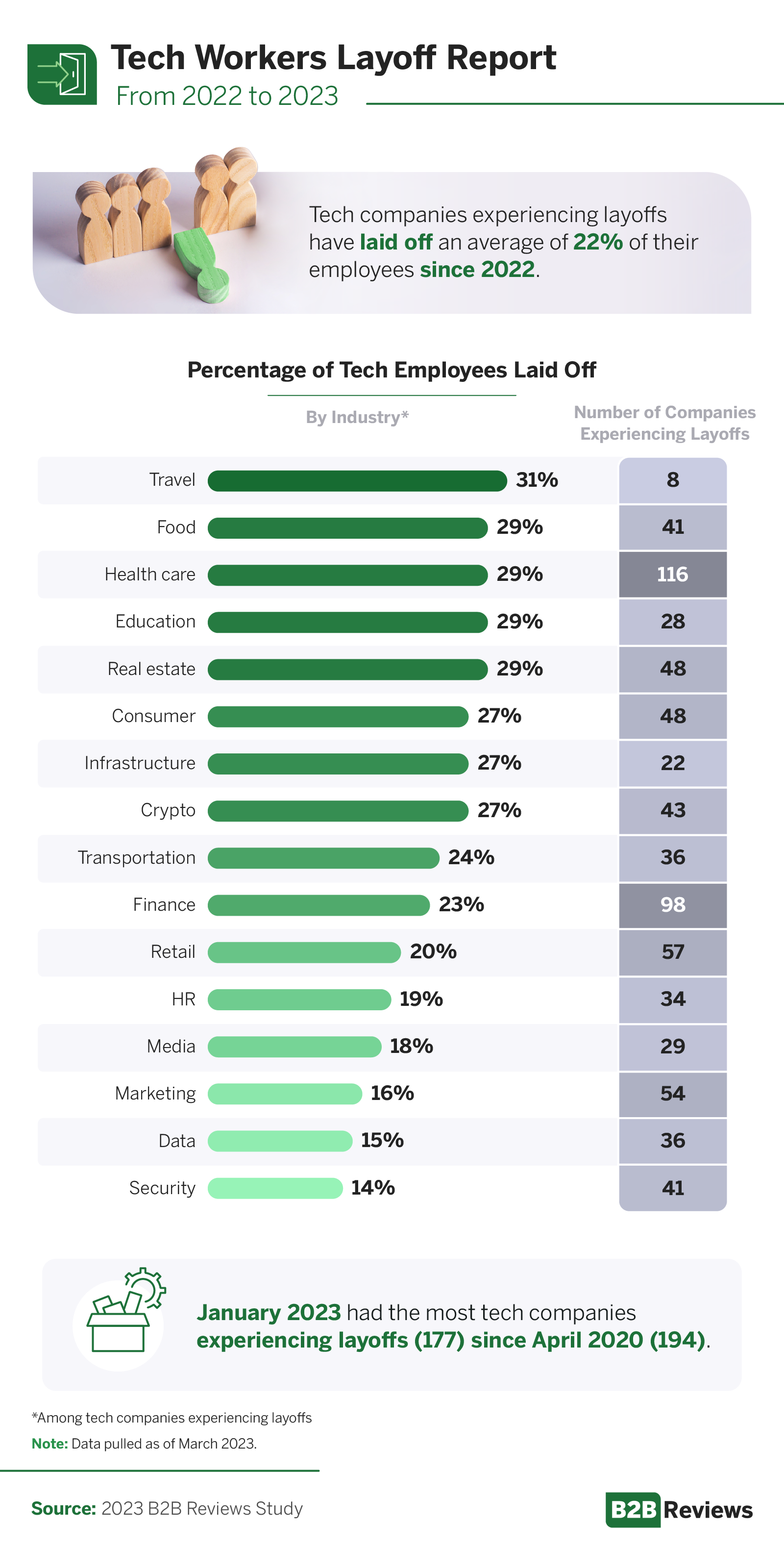
Since 2022, tech companies have laid off an average of 22% of their workforce. The situation worsened in January 2023, when 177 tech companies underwent layoffs—the highest number on record since 194 companies in April 2020. Tech companies operating in the travel industry were affected the most, having laid off 31% of their workforce.
Health care and finance companies have also been hit hard by layoffs, with 116 health care companies and 98 finance companies having let go of tech employees. Additionally, 57 retail companies reported laying off tech workers, and volatility in the crypto market has resulted in more tech job cuts.
State of Tech Companies
Companies that have raised over $100 million often hold a significant position in the market, and layoffs within these companies can sometimes trigger a snowball effect within the industry. We examined some influential companies to see how they handled job cuts.
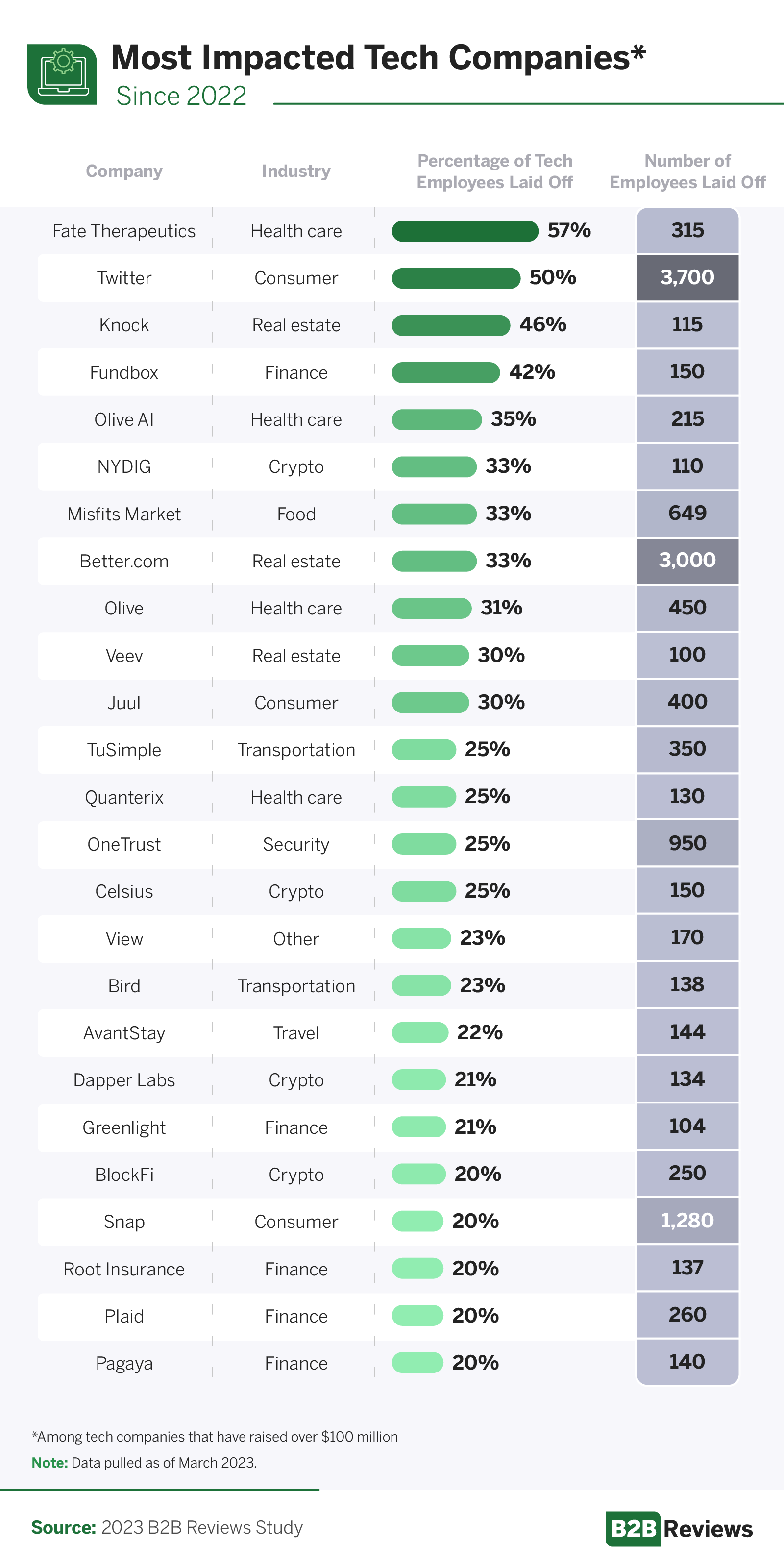
While Fate Therapeutics laid off the highest percentage of employees (57%), the number of workers affected was dwarfed by Twitter’s mass layoffs. Elon Musk’s takeover of the social media powerhouse trimmed the company by 50% and affected a startling 3,700 employees, sending shockwaves throughout the tech industry. Real estate company Better.com had the second most layoffs at 3,000, followed by consumer company Snap with 1,280.
Finance and crypto companies seemed to struggle more than others with the financial downturn, accounting for one-third of the companies on our most impacted list. Fundbox, the most affected finance company, laid off 42% of its employees, leaving 150 jobless. Crypto company NYDIG lost 33% of its workforce, the highest percentage of crypto-related jobs, resulting in 110 laid-off workers.
Overcoming the Adversity
What happens to employees unlucky enough to find themselves laid off? We looked at LinkedIn data to see how quickly (or slowly) employees bounced back after being let go.
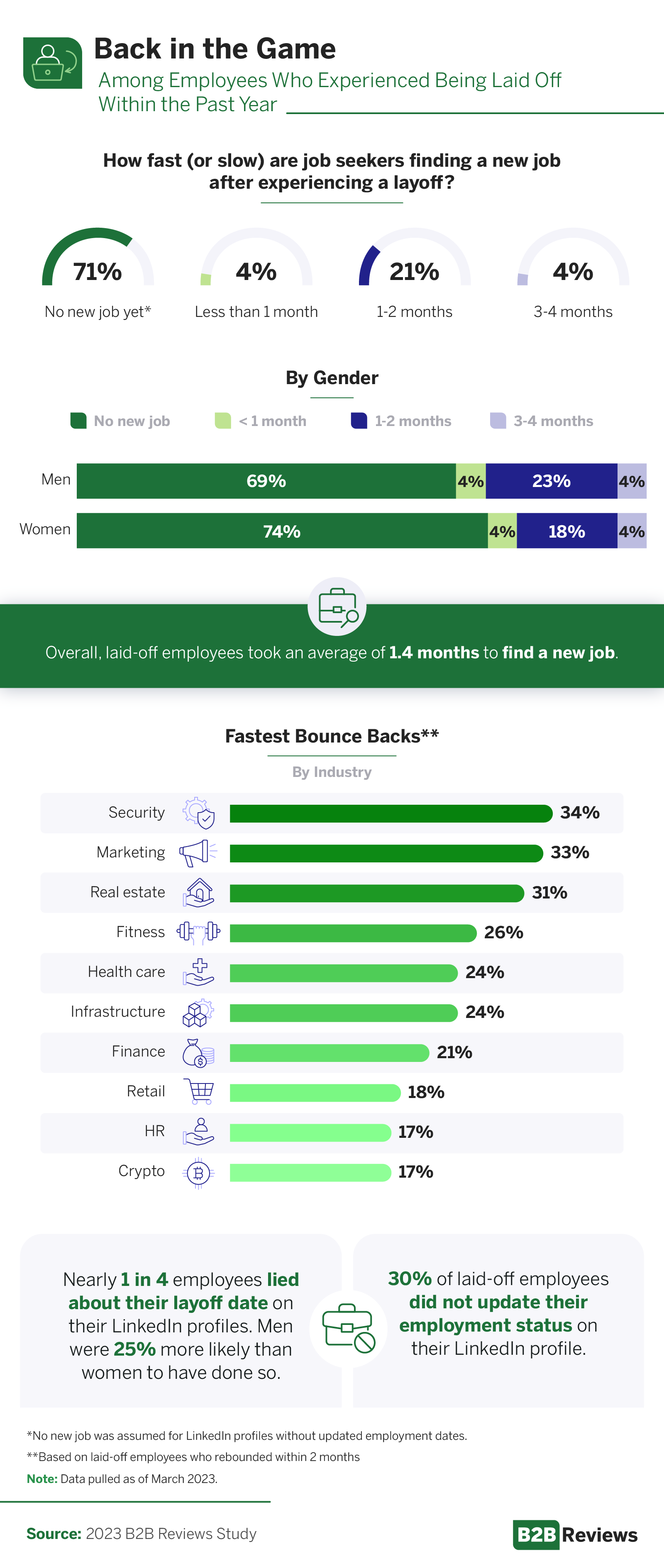
According to our study, 71% of those affected by tech layoffs had yet to find a new job since being laid off in 2022. Interestingly, 74% of women laid off from tech companies couldn’t find employment, compared to 69% of men. Of those who bounced back, 25% found new employment within two months, and another 4% took three to four months. The average time for finding a new job after being laid off was approximately six weeks.
Among industries, security had the fastest bounce back rate at 34%, closely followed by marketing (33%) and real estate (31%). Human resources and crypto had the slowest bounce back rates, at just 17% each.
Our study also revealed that almost 1 in 4 employees lied about their layoff date on their LinkedIn profiles, with men being 25% more likely than women to do so. In addition, 30% of laid-off employees didn’t update their employment status on their LinkedIn profiles, which could result in missed job opportunities.
What Hiring Managers Want You To Know
Finding a job can prove exhausting, but there are ways to make your profile stand out. We asked hiring managers to share their experience with layoffs and offer advice to eager job seekers. Here’s what they had to say.
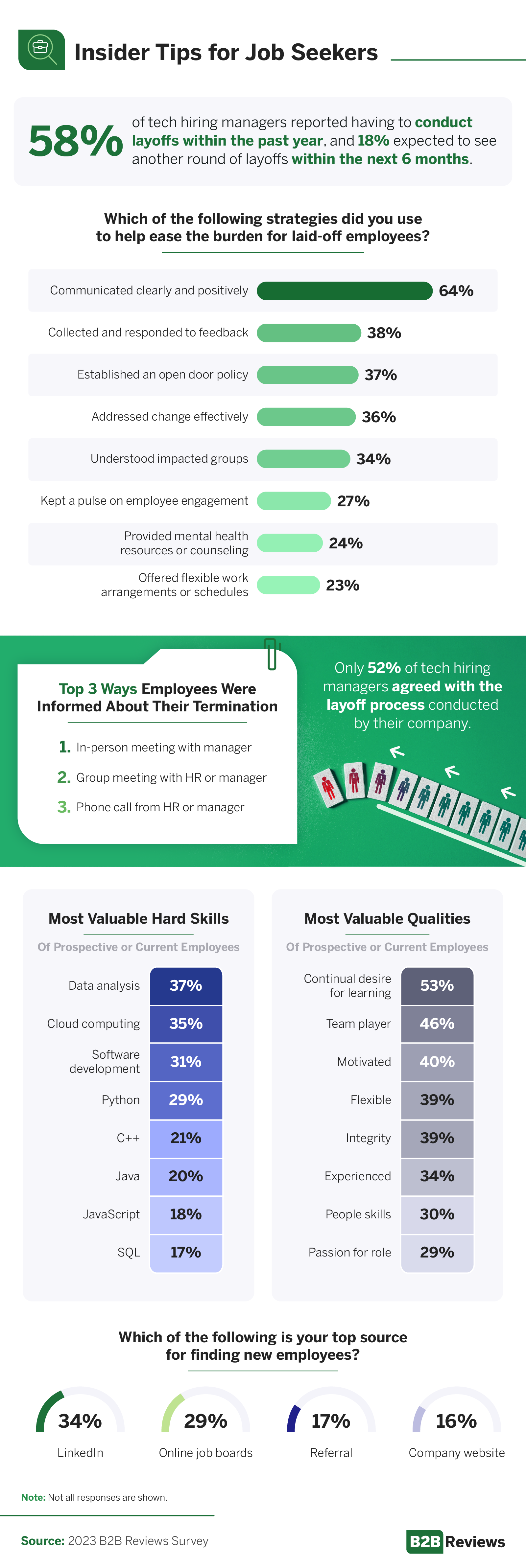
Hiring managers have a difficult job when layoffs come around, and 58% of those surveyed conducted them within the past year. Another 18% expected to see another round of layoffs within the next six months. To help ease the burden for affected employees, 64% of managers strove to communicate clearly and positively, and 37% established an open door policy to provide support.
When searching for new employees in tech, 34% of hiring managers preferred to use LinkedIn and 29% used online job boards. Hiring managers want employees with knowledge in data analysis, cloud computing, and software development. They also want employees who are eager to learn and are good team players. Job seekers in the tech industry might increase their prospects by emphasizing these skills and qualities in their profiles.
Surviving Unemployment and Starting the Job Search
Being laid off from a job can be overwhelming and stressful, especially when paying the bills. We asked employees who were laid off within the past two years about their strategies for managing finances in unemployment. We also asked them about their job search. Let’s take a look at their experiences.
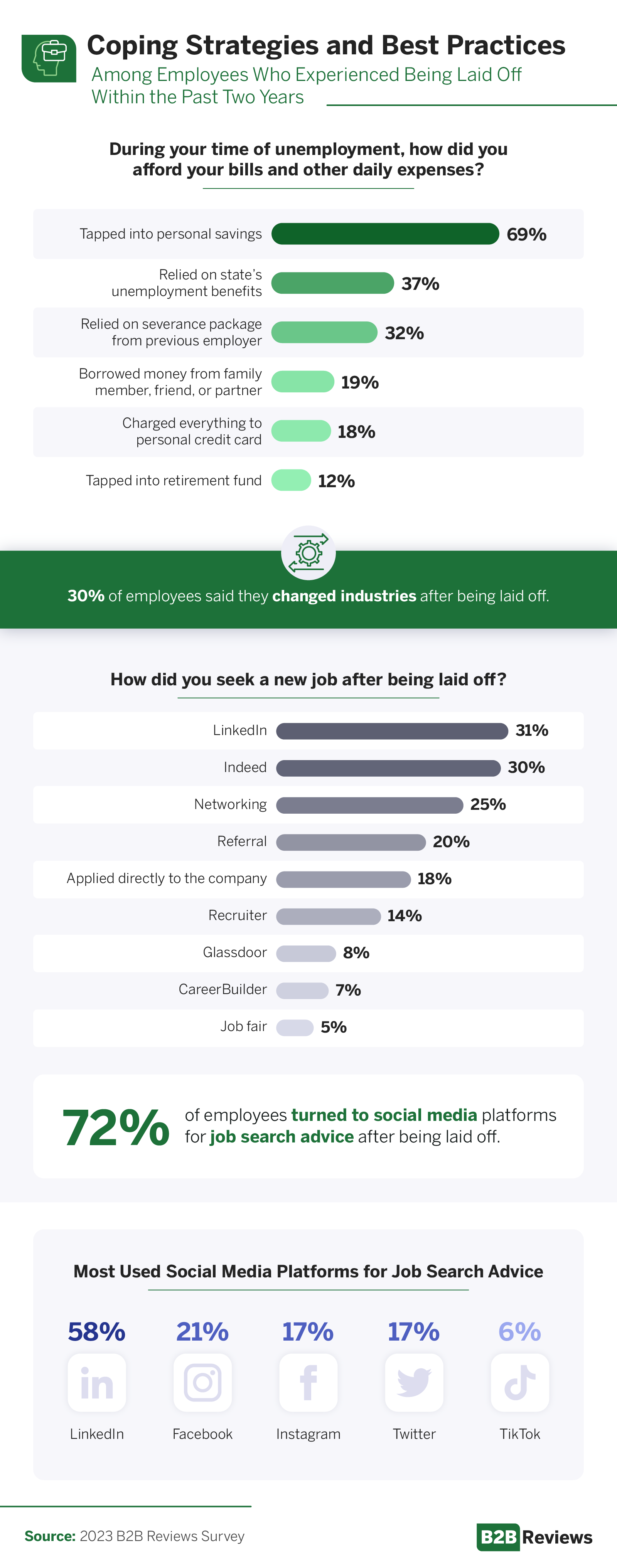
During unemployment, 69% of respondents tapped into their personal savings to cover daily expenses. Only 37% relied on state unemployment benefits, and just 32% relied on severance packages.
When looking for a new job, 30% of those who were laid off transitioned to a different industry. Most job seekers found such new opportunities through social media; LinkedIn was the preferred platform for professional advice and job hunting.
Lessons Learned from Tech Layoffs
The recent spike in tech layoffs affected many industries, with major companies losing up to over half their workforce. While tech companies may have to resort to layoffs during turbulent times, hiring new employees can become challenging once the market improves. Therefore, companies may want to prioritize employee retention and consider alternative cost-cutting measures.
When unavoidable layoffs loom, companies can offer employee training programs and career transition services to assist laid-off employees. Individuals who are laid off should promptly and accurately update their profile on LinkedIn and other online job boards to maximize their chances of finding new employment opportunities.
As the tech industry moves forward, individuals and tech companies need to balance competition with cooperation and come together to build a more resilient and sustainable industry.
Methodology
For this study, we pulled data from Layoffs.fyi to analyze tech startup layoffs in the U.S. from 2022 to 2023. We specifically focused on the total number of startups conducting layoffs in each industry, and the number and percentage of laid-off employees. We collected information on the laid-off employees and checked their LinkedIn profiles to determine how quickly they found new employment where possible. In total, our data was based on 935 tech companies/startups and 999 specific employees who were laid off. No statistical testing was performed on this data, so the above claims are based on means alone. We also surveyed 494 tech professionals with hiring capabilities and 503 employees laid off within the past two years.
About B2B Reviews
B2B Reviews simplifies B2B decision-making for managers in small and mid-sized businesses by providing buying guides and expert reviews on everything from Business Loans to Payroll Software. Our expert insight and free tools help streamline the B2B purchasing process and connect buyers with top-quality brands.
Fair Use Statement
You’re welcome to share this study about tech industry layoffs, but please do so for noncommercial purposes only and provide a link back to this article so readers can access our full findings and methodology.
Related Articles